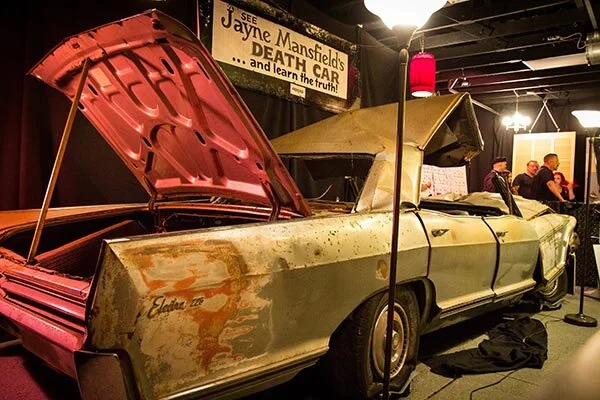Collecting Hollywood’s Cremains
Los Angeles’ Dearly Departed Tours and Artifact Museum proves celebrities are always fascinating, even when they’re dead.
By Liz Ohanesian
We’ll all die eventually. But only some of us will end up in a museum. (Art: Kati Kirsch)
On a Monday afternoon in October of 2018, a long-overdue memorial for Mihaly “Michu” Meszaros was being prepared inside of a small, Hollywood museum.
Thanks to dogged collection efforts, a smattering of the late performer's personal effects had all ended up there, including a pair of cowboy boots, a straw hat, and a blue, terry cloth bathrobe with the phrase "The Greatest Show on Earth" sewn onto the back.
Michu's director's chair was also there, his name printed in gold letters across its dark blue fabric. An empty wooden box lay on its seat. Later, it would be used to contain Michu’s ashes.
Michu, who was two-feet and nine-inches tall, started out as a circus star, but is perhaps best known for his role as the furry alien ALF on the titular ‘80s NBC sitcom.
After his time under the big red tent, the Hungarian-born performer explored other avenues of entertainment. He appeared in films like Big Top Pee-Wee, the horror-comedy Waxwork, and he even toured with Michael Jackson.
Related:
“The People Who Talk To Andy Warhol From Beyond The Grave”
“7 Weird Facts About Body Farms”
“Visiting Dead Relatives on Google Street View”
During his lifetime, Michu left his mark in both the media and in his hometown. There's even a street named after him in Hawthorne, the Southern California city where he lived.
Despite this, when Michu died at the age of 76 from underlying health problems related to a previous stroke, there weren't any funds for a burial, so he was cremated instead.
That was in 2016 and now, more than two years later, the actor’s remains have finally found a permanent home inside a Hollywood museum dedicated to dead celebrities.
A fittingly compact memorial for the famously compact actor, Mihaly "Michu" Meszaros. (Dearly Departed)
Located on Santa Monica Boulevard, smack-dab across the street from the Hollywood Forever Cemetery, Dearly Departed Tours and Artifact Museum is the brainchild of Scott Michaels, a self-described celebrity death and scandal expert. In addition to offering macabre-themed bus tours around Los Angeles, the unique destination is also a place to see mementos, especially death-related ones, from famous entertainers of yore.
The museum’s centerpiece is the totaled car from the crash that killed Jayne Mansfield, one of the first Playboy playmates.
Also on display is Rock Hudson’s Rolodex, a used cigarette butt from Carrie Fisher, and a piece of the fireplace from Sharon Tate’s home. From dentures to long expired bowel medications, so long as it belonged to someone high-profile who is now-dead, Michaels can usually find a home for it in Dearly Departed’s museum.
This, of course, includes ashes.
For a handful of people and two dogs, Dearly Departed has also become a final resting place for Hollywood’s cremains. A portion of the incinerated body of Ken Weatherwax, the actor who played Pugsley Addams in the 1960s Addams Family television series, is there. (The rest are at Valhalla Memorial Park in North Hollywood.)
Even the remains of Michaels’ own mother is there, and now, so is Michu.
Jayne Mansfield met her maker when this 1966 Buik Electra 225 crashed into a tractor-trailer at a high speed outside of New Orleans in 1967. (Liz Ohanesian)
An early fascination with death
Michaels grew up in Detroit in the 1960s and '70s near an intersection where car wrecks were common. He helped his mom collect glass debris from the scenes, which she would use to make mosaics.
"It wasn't that we had to do something weird with this accident stuff," Michaels told OK Whatever. "It was just what we had and she liked doing that kind of stuff."
Still, Michaels figures this probably helped desensitize him to death a little bit. In 1979, a young woman was killed in Michael’s hometown.
He went to the abandoned house where the murder occurred and took the address sign, which became the first piece in his collection of death artifacts. For decades, it stayed in a box. Now, it hangs with a newspaper clipping inside Dearly Departed.
"There are 20-some people every day learning about her," he said. "Maybe it's not the way that she wanted to be remembered. However, she's remembered, and that's what we do."
When Michaels first moved to Los Angeles, he worked for a Hearse-driven tour company called Grave Line that, despite going out of business, inspired Michaels to launch his own spooky tourist attraction, Dearly Departed, years later.
He opened the museum’s first iteration in 2012 on Sunset Boulevard, before moving to its current space in 2017. Now located a mere block from the city’s most high-profile graveyard, Michaels said you can walk to Judy Garland’s grave and back in under 20 minutes.
Scott Michaels has worked in the death industry for decades, starting with purchasing the website domain findadeath.com in 1997. (Dearly Departed)
You can never have too many death mementos
Many of the items at Dearly Departed’s museum were scavenged by Michaels himself.
The door to the hotel room where the legendary drag queen Divine died came into his possession when he was driving home from Phyllis Diller's house, after buying one of the comedian's paintings. Because the hotel was set for demolition, Michaels managed to convince the on-site guard to let him search the property and later return with friends and tools to remove the infamous door and take a few other items.
The butt of a cigarette that had once perched between Carrie Fisher’s lips can be found at the museum. (Dearly Departed)
Though not as common, donations are also accepted at Dearly Departed. Karen Carpenter's sink came into the museum’s possession from someone who worked in construction.
As Michaels sees it, Dearly Departed's work is in a similar vein to archaeology. He feels tasked to preserve and record these bits of pop culture history, however banal or un-extraordinary they may seem from an academic standpoint.
But there are limits to what Michaels will allow in his museum. Though he accepted a flower plucked from the casket of Charles Manson, he turned down an offer for the criminal’s ashes.
"I don't see him as this giant bogeyman that a lot of people do see him as, but I don't want that in here," Michaels explained. "I don't want that vibe in here."
A flower and pamphlet pilfered from Charles Manson’s funeral on March 17, 2018. (Dearly Departed)
Selling tickets while still paying tribute
Dearly Departed walks a fine line. It caters to morbid curiosities and at the same time makes money off of some of the most sensationalized deaths in recent history.
But there's a respectfulness to Michaels' company as well. Once a year, Michaels hosts a weekend-long gathering for kindred spirits that includes tours and parties, sometimes organized under special themes.
They also use the weekend to pay tribute to someone who has passed, usually by paying for their burial expenses.
Thanks to their efforts, Johnny Arthur, an obscure actor from the first half of the 20th century who played gay characters in pre-code Hollywood and who later had a role in The Little Rascals, finally got a tombstone with his name on it after spending more than 60 years in an unmarked grave. Ken Weatherwax’s plot at Valhalla Cemetery in North Hollywood was secured in 2017 thanks to their efforts, for 2018, the Dearly Departed team chose to honor Michu.
A display memorializing the actor Ken Weatherwax who died of a heart attack in 2014 at the age of 59. (Dearly Departed)
That following Sunday, Dearly Departed held Michu's memorial.
Michaels read a eulogy prepared by one of Michu's friends as well as comments written by others who knew him. They recalled his struggle, how he left his original home of Hungary due to discrimination because of his small size. They wrote of his friendship with Michael Jackson and shared anecdotes using the strong language that Michu was said to utter. They remembered him as a whole person, not just as a spectacle in the circus or the guy hidden within the ALF suit.
At the event, Michaels revealed Michu's new shrine. The director’s chair had been encased in glass, the box of remains still on its seat. The bathrobe, cowboy boots, and straw hat were stored inside the display box, too, as well as photos of Michu as ALF and one of him with Michael Jackson and Lisa Marie Presley. A large photo of Michu from his circus days and a placard from the street that bears his name were also included.
Not everyone understands what Michaels is doing with Dearly Departed.
"People have their preconceived notions,” he said. “They assume you're one of those gravediggers or something like that.”
But despite its creepy factor, most who visit can also pick up on the care and reverence that goes into each individual display, as well. As Michaels pointed out, “Either you get it or you don't."
















A pop-up museum in Los Angeles tried to find the answer.